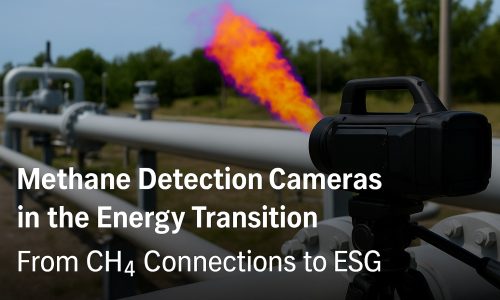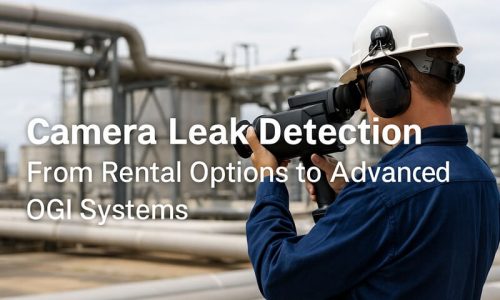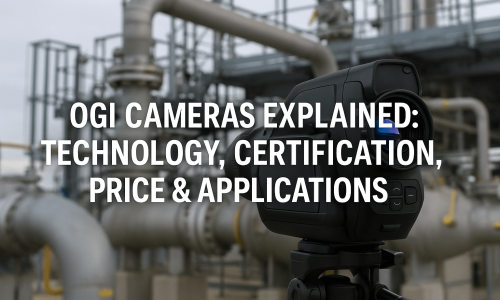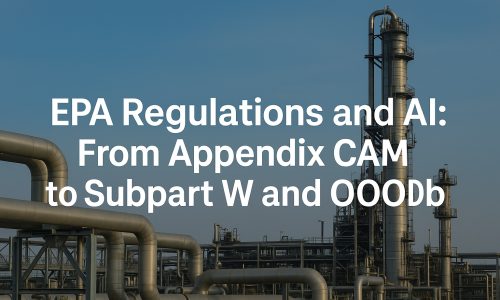In the world of industrial safety and environmental compliance, leak detection is no longer a reactive task – it is a proactive responsibility. Whether for oil and gas operators, chemical processing facilities, or energy producers, the ability to accurately identify fugitive emissions is critical. Traditional tools like gas sniffers or pressure testing often fall short in sensitivity, efficiency, or practicality. That’s where thermal imaging leak detection reshapes the landscape – offering a safer, faster, and more reliable way to see what the eye cannot.
With over four decades of experience in high-end electro-optics, OPGAL has pioneered this shift. Its flagship product, the EyeCGas 2.0, is not just a thermal camera to find leaks – it’s a comprehensive platform for thermal imaging gas leak detection in the harshest industrial environments.
How Thermal Imaging Detects Leaks
At its core, thermal imaging to detect leaks involves using infrared technology to capture invisible gas emissions. Certain gases absorb and emit infrared radiation in specific wavelengths, and thermal imaging cameras are designed to visualize this interaction.
Unlike contact-based methods, thermal imaging allows inspectors to survey pipelines, valves, and tanks from a distance, identifying even the smallest leaks without disrupting operations. With real-time visualization and recording capabilities, leaks can be documented, quantified, and resolved before they become safety hazards or compliance issues.
For example, methane – one of the most common and potent greenhouse gases – is invisible to the naked eye but highly visible through a properly calibrated OGI camera. OPGAL’s EyeCGas 2.0 is engineered with specialized spectral filters that target this exact infrared window, making thermal imaging gas leak detection not just possible, but remarkably precise.
EyeCGas 2.0: A Thermal Camera to Find Leaks — Accurately and Safely
What separates the EyeCGas 2.0 from other thermal cameras is its combination of sensitivity, safety certification, and ease of use. Designed specifically for the oil and gas industry, the camera meets stringent international standards such as ATEX II and Class I Div 2, making it safe to use in hazardous locations.
With a Noise Equivalent Temperature Difference (NETD) of <10mK, the EyeCGas 2.0 is the most sensitive OGI camera in its class. It can detect methane leaks as small as 0.35 g/hr, exceeding the EPA’s requirements under NSPS OOOOa and Appendix K.
Even more, the device comes with three operator-replaceable filters, making it flexible across a wide range of gases — from VOCs in the 3.2μm–3.4μm band, to heavier hydrocarbons and CO₂. Whether you need a thermal camera to find leaks at close range or across a long-distance inspection route, EyeCGas 2.0 is optimized for both.
EPA Compliance and the Role of Thermal Imaging Leak Detection
As regulatory frameworks tighten globally, thermal imaging leak detection has become more than an advantage — it’s becoming a requirement. The U.S. Environmental Protection Agency (EPA) is currently advancing new protocols under Appendix K, which define acceptable methodologies for leak detection of VOCs and greenhouse gases using Optical Gas Imaging.
Unlike gas detectors that require daily bump testing and monthly calibration, thermal imaging systems such as the EyeCGas 2.0 offer maintenance-free operation. According to the EPA’s own analysis (ERG report, 2015), the EyeCGas platform met or exceeded performance expectations compared to traditional detection methods.
By adopting thermal imaging to detect leaks, operators align with both regulatory expectations and environmental stewardship. It enables rapid identification of emissions, reduces operational risks, and ensures ongoing compliance without operational downtime.
The Future of Emission Monitoring Starts with Thermal Imaging
As industries seek smarter, cleaner, and more efficient methods to monitor emissions, thermal imaging leak detection is emerging as the gold standard. It’s faster than sniffers, more visual than sensors, and safer than manual inspections.
Thermal imaging to detect leaks not only supports proactive maintenance but also plays a critical role in reducing methane and VOC emissions — key contributors to climate change. By leveraging cameras like the EyeCGas 2.0, facilities gain a non-invasive, real-time view of their infrastructure, empowering teams to act before leaks become liabilities.
Whether you’re designing a leak detection program or upgrading your equipment with a new leak detection camera to meet EPA standards, OPGAL’s EyeCGas 2.0 is the thermal camera engineered to get the job done — accurately, safely, and efficiently.





